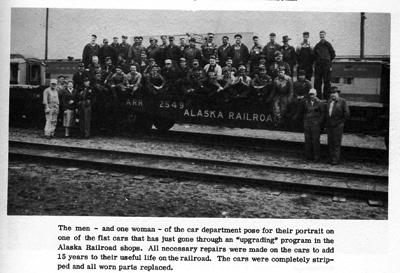
Building historically accurate HO scale models of Alaska Railroad freight cars has become a research challenge. While there are some photos in which freight cars appear in the background or incidental to the main subject there are few "builders" photos before the 1948 reconstruction. While I have partial rosters from six different years from 1923 until 2008, none show renumbering of cars in transition or rebuild except for skimpy information on Troop sleeper and kitchen cars. Some cars moved into the Engineering department MOW fleet and were renumbered. Retirements are rarely mentioned and only occasionally is mention made of new rolling stock arriving.
I, therefore, require a "dated" photo to reveal the car type and number before setting out on a building project.
My model of fish belly steel flat car #2549 began with a poor photo on page 863 of The Alaska Railroad by Bernadine Prince. The caption of the photo shows the car department staff posing for their portrait on the flat car that had just gone through an "upgrading" program in the Alaska Railroad Shops. All necessary repairs were made on the cars to add 15 years to their useful life on the railroad. The photo clearly shows the fresh 1957 lettering style.
49 cars numbered 2540-2596 were still listed in the 1963 roster, which also confirmed the width at 9'3" and length 40' 2" with 50 ton capacity. By 1976 only #2569 was still on roster equipped with corner posts for containers and GS general service.
With no documented history before 1957 or after 1976, one has to question if the entire class was subject of a renumbering when rebuilt from cars that had been around during or even before WWII.
ARR Flat #3107 was photographed in Fairbanks in 1947, an example of 40 cars in the 3101-3140 class listed in an undated FREIGHT EQUIPMENT SUMMARY from the 1930's.
I proceeded to build a general service flat car with characteristics common to these prototype photos. You can decide if you want an early car, #3107, or one in service from 1957 to 1976 such as #2549.
Either car can be built in about 6 hours starting with the Red Caboose 42' Flat Car With Fish Belly Side Sills. This was a common USRA design which was modified and built during the 20's through the 40's for many railroads.
The kit is for a 42' car so start by removing 22 inches from the center cross section of the car kit. I alternated the splices between the flat car body side sills, the deck insert, the main frame and the sub frame. Cut about 24" off the end of the car weight. When this is all assembled the splices should be at different locations in each of the components so it goes together as a strong assembly. When you have the kit in hand this muddle will becomes clear and obvious.
The kit has 12 stake pocket down each side and we want only 10. I solved this problem by installing the pockets at each end and then spacing over the next three pockets the width of the pocket toward the center. This means using one existing hole and drilling another toward the center of the car to accept the pin on the back side of each pocket. The last two pockets were moved over a full pocket width toward the center on each side. You can do this pretty much to match your prototype photo. While checking the photos determine if poling pockets were used on your car. In the case of #3107 they were not.
I installed wire grab irons, steal stirrup steps and a steel staff for the brake wheel as the plastic ones would soon fail in service in our arctic weather conditions. I used ACC to mount these dissimilar materials to the plastic car body. Move the brake staff from the kit location outside the grab iron, and place it next to the draft gear box per the prototype. I used a piece of .020 wire with a 90 degree bend 1/8 inch from the bottom. The staff is then installed with the bent end going through a hole near the bottom of the end sill. The original brake wheel can be attached with ACC and the rest of the brake hardware cut back and applied over the wire on the end beam. Now you can apply the grab iron out toward the edge of the car.
Plastic wheel/axle sets were replaced with Kadee 33" wheels after tuning the side frames with a reamer. A set of Kadee #518 scale couplers, black paint and white decals finished the job for #2569. (I am still waiting to make up the white ALASKA RAILROAD in 6 inch size to match.)
If you build the earlier version #3107, it would be appropriate to use rib backed wheels and Oxide Red paint with white or yellow letters.
This is an inexpensive model with limited time investment representing
a versatile car with many years service on the Alaska Railroad.
 |
 |